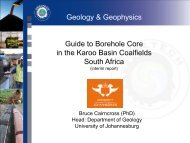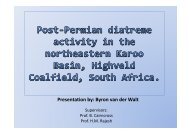coaltech upper olifants river catchment wetland inventory ...
coaltech upper olifants river catchment wetland inventory ...
coaltech upper olifants river catchment wetland inventory ...
You also want an ePaper? Increase the reach of your titles
YUMPU automatically turns print PDFs into web optimized ePapers that Google loves.
In a <strong>wetland</strong> study at Douglas Colliery (8) by Marneweck (2004b) it was determined that<br />
<strong>wetland</strong>s in this area were modified by agriculture and mining related impacts and can<br />
therefore not be regarded as pristine. Most of the <strong>wetland</strong>s are largely modified and the<br />
mining activities may cause some of the <strong>wetland</strong>s to degrade to a critically modified status.<br />
The <strong>wetland</strong>s at the Middelburg Mine (9) were assessed as part of an ecological assessment<br />
conducted in the mine area. Two Vulnerable Red Data species were observed in the<br />
<strong>wetland</strong>s during the site visits. These species are the Grass Owl (Tyto capensis) and the<br />
Marsh Sylph (Metisella meninx). Various protected species also occurred in the <strong>wetland</strong>s.<br />
The <strong>river</strong>ine system in this area suffered a major loss in ecosystem functions, but the<br />
<strong>wetland</strong>s in general are still in a moderate condition (Natural Scientific Services, 2006).<br />
A <strong>wetland</strong> assessment was conducted on the Steenkoolspruit in the Kriel South area (10).<br />
During this assessment it was found that the species diversity in the <strong>wetland</strong> is high. It was<br />
therefore suggested that a more detailed <strong>wetland</strong> assessment be conducted to compare the<br />
species diversity in the <strong>wetland</strong> to the species diversity present in similar <strong>wetland</strong> systems in<br />
the area. The <strong>wetland</strong> was found to be slightly modified (Marneweck 2001).<br />
In a follow-up study in the Kriel South area (10) the species diversity in the <strong>wetland</strong>s at<br />
Steenkoolspruit, Blesbokspruit and Viskuile <strong>wetland</strong>s were investigated. The highest species<br />
diversity was found at the Steenkoolspruit and the lowest species diversity at the<br />
Blesbokspruit. The floodplain <strong>wetland</strong>s at Viskuile and Steenkoolspruit were found to be only<br />
slightly modified, while the floodplain of the Blesbokspruit is heavily degraded. The hillslope<br />
seepages at the Viskuile were also heavily impacted upon by cultivation and draining of the<br />
<strong>wetland</strong>s, whereas the hillslope seepages at the Steenkoolspruit and Blesbokspruit, although<br />
slightly degraded, were in a better condition (Marneweck and Bell, 2002).<br />
In a <strong>wetland</strong> assessment conducted by Marneweck and Batchelor (2004) on the proposed<br />
new strip mine area at Khutala Colliery (11) it was determined that most of the <strong>wetland</strong>s in<br />
the area are moderately modified. Some of the functions and habitat features of the <strong>wetland</strong>s<br />
are lost. Since these <strong>wetland</strong>s are located in an area proposed for future strip mine<br />
operations the <strong>wetland</strong>s will be lost if mining authorisation is granted (Marneweck and<br />
Batchelor, 2004).<br />
Wetland Database for UORC - 67 -




